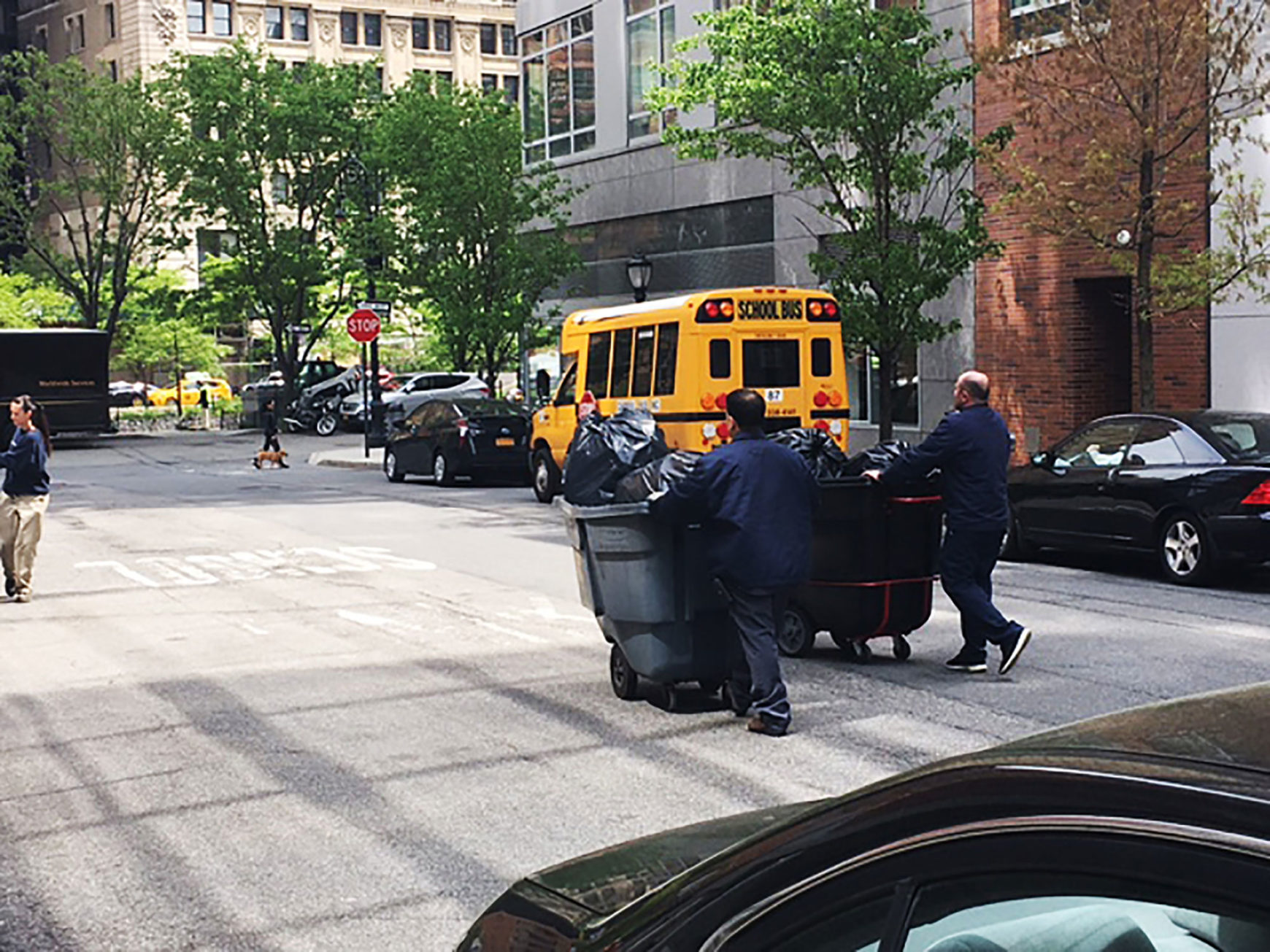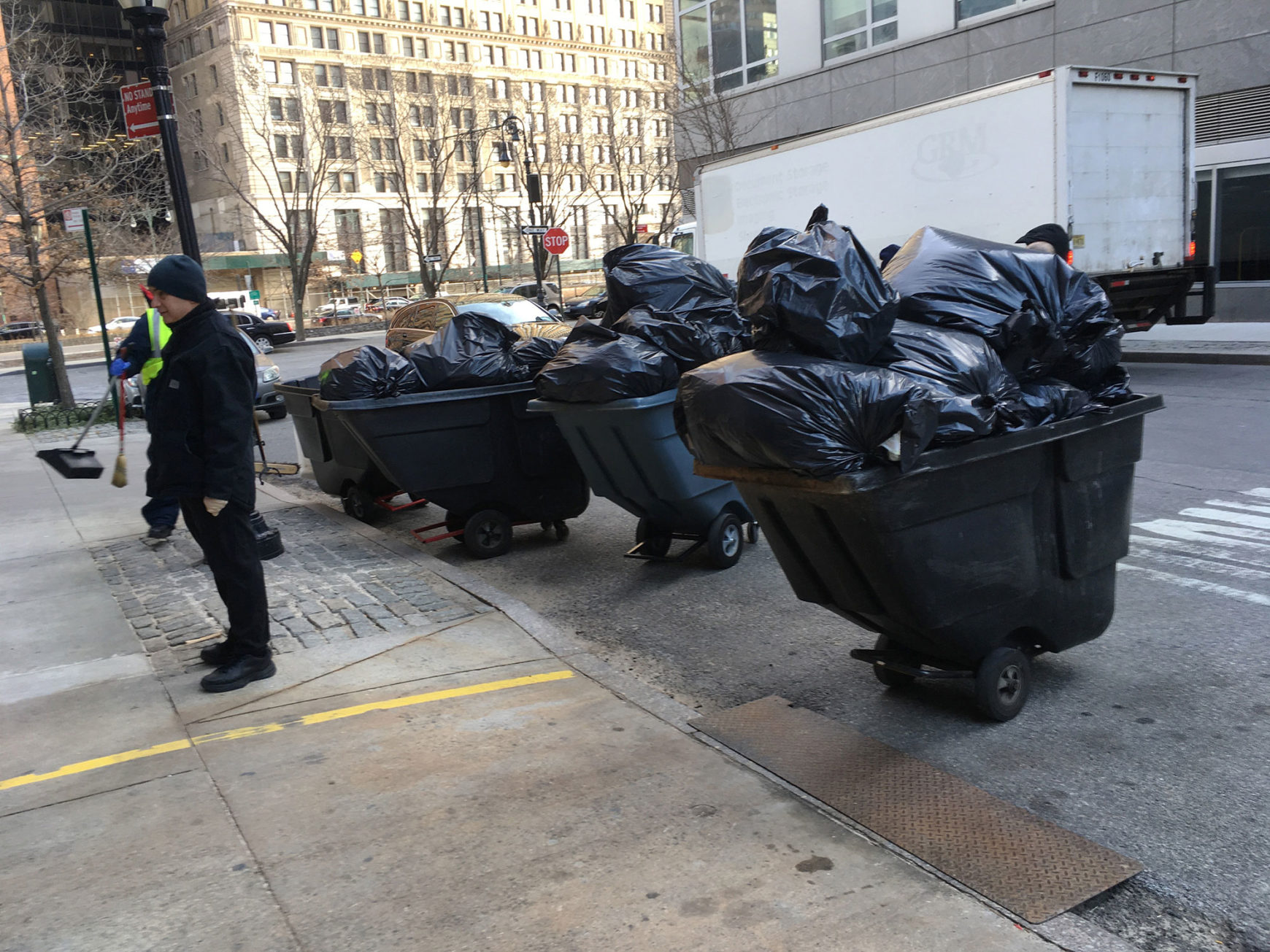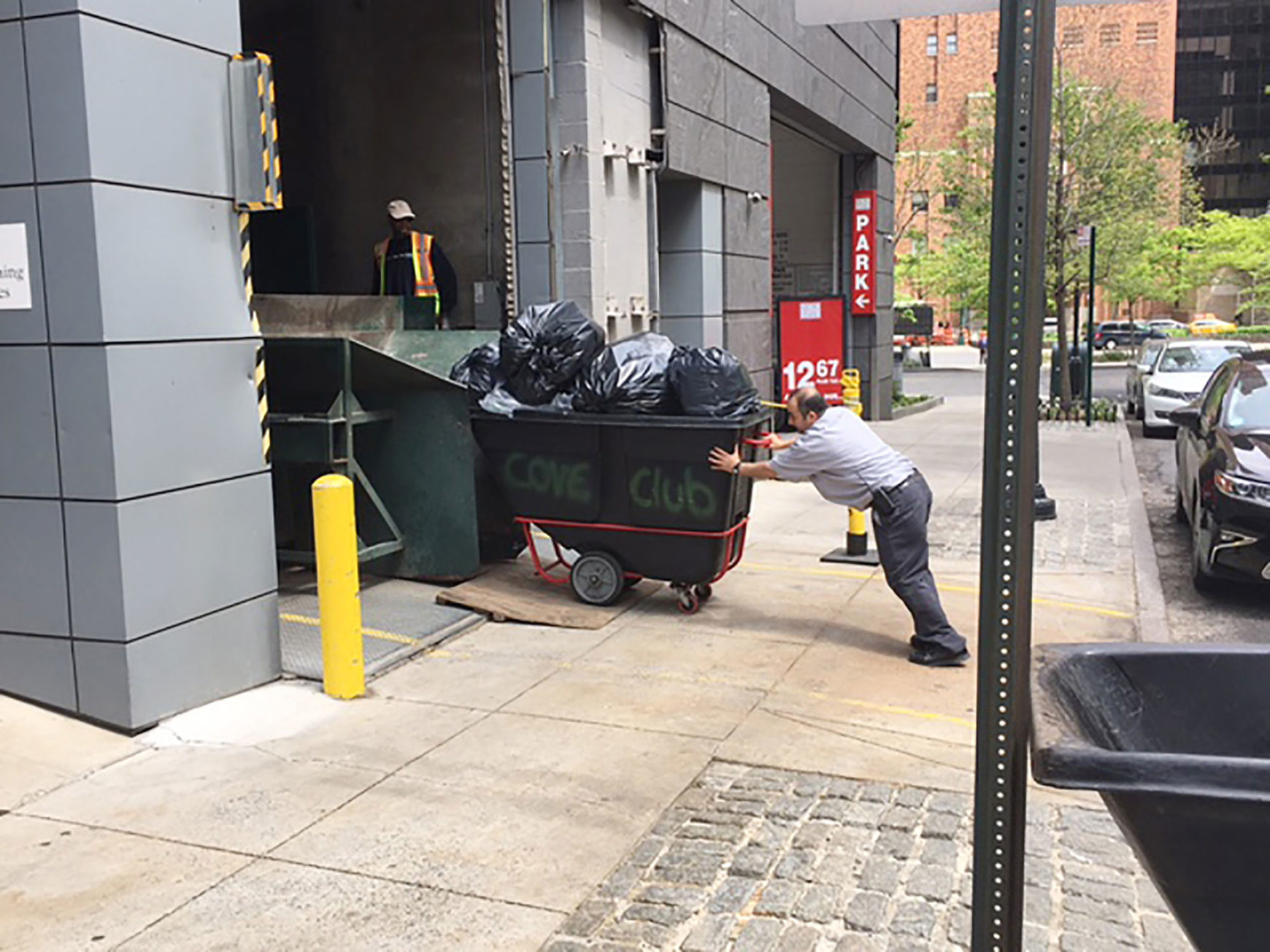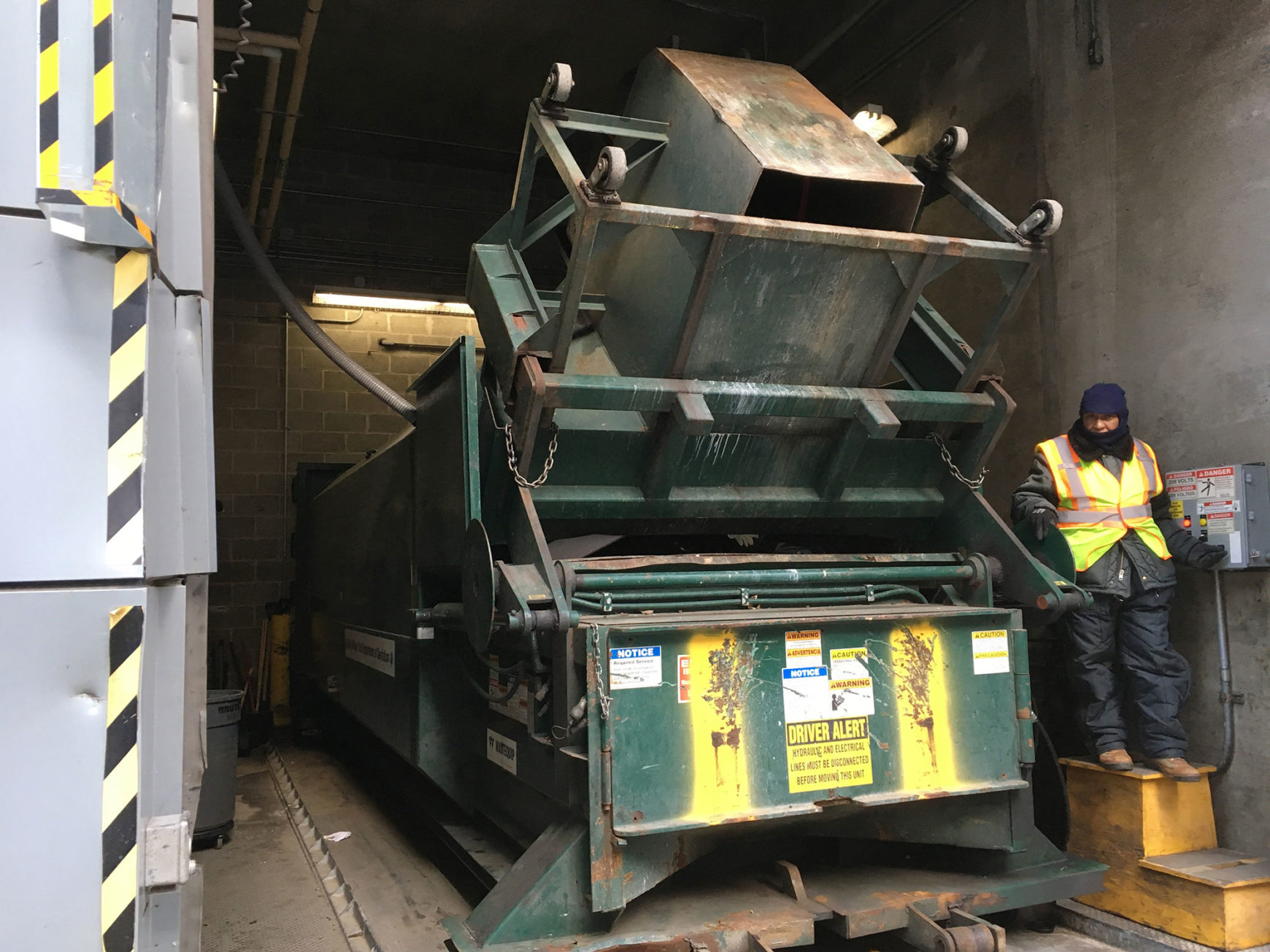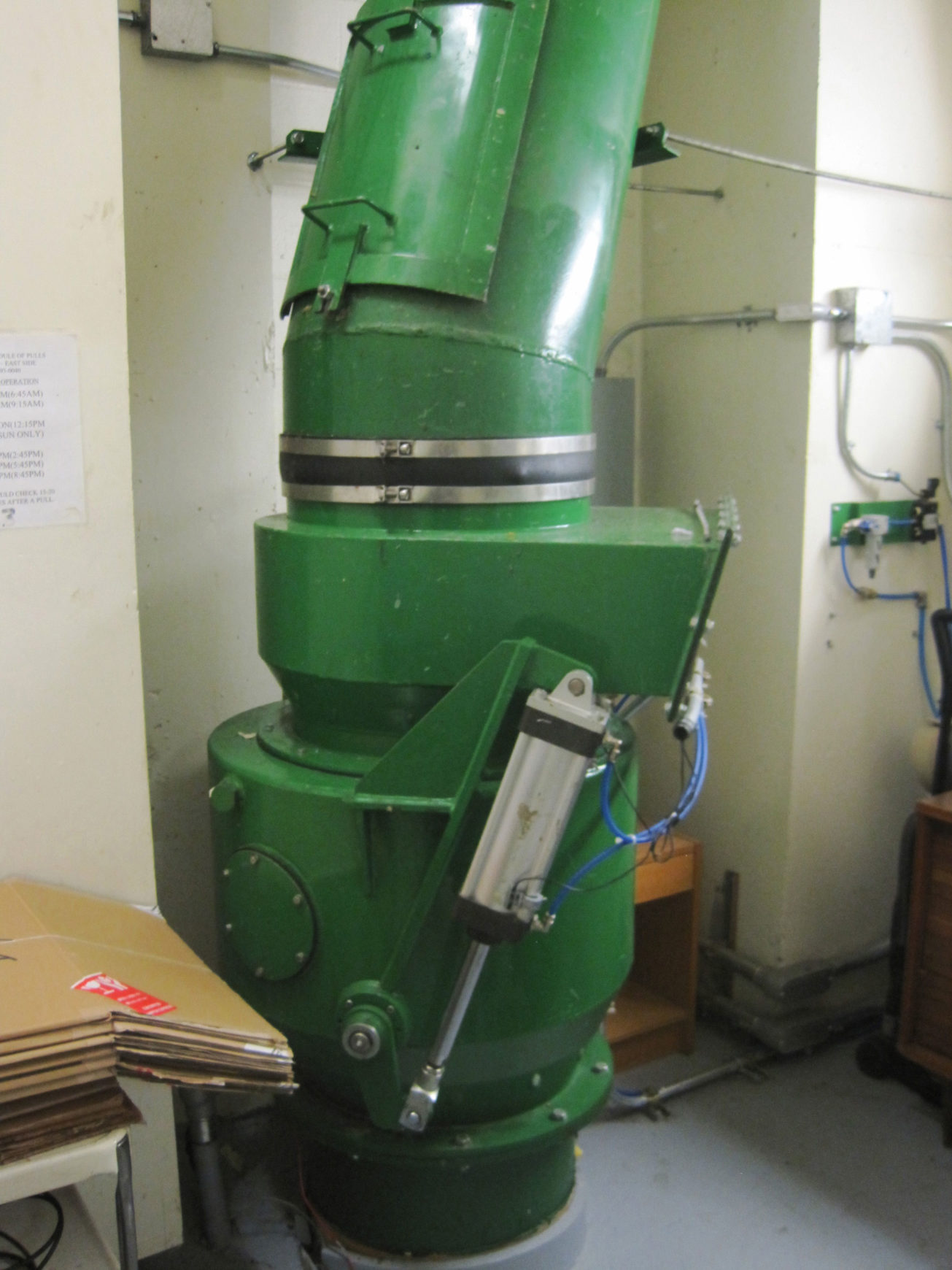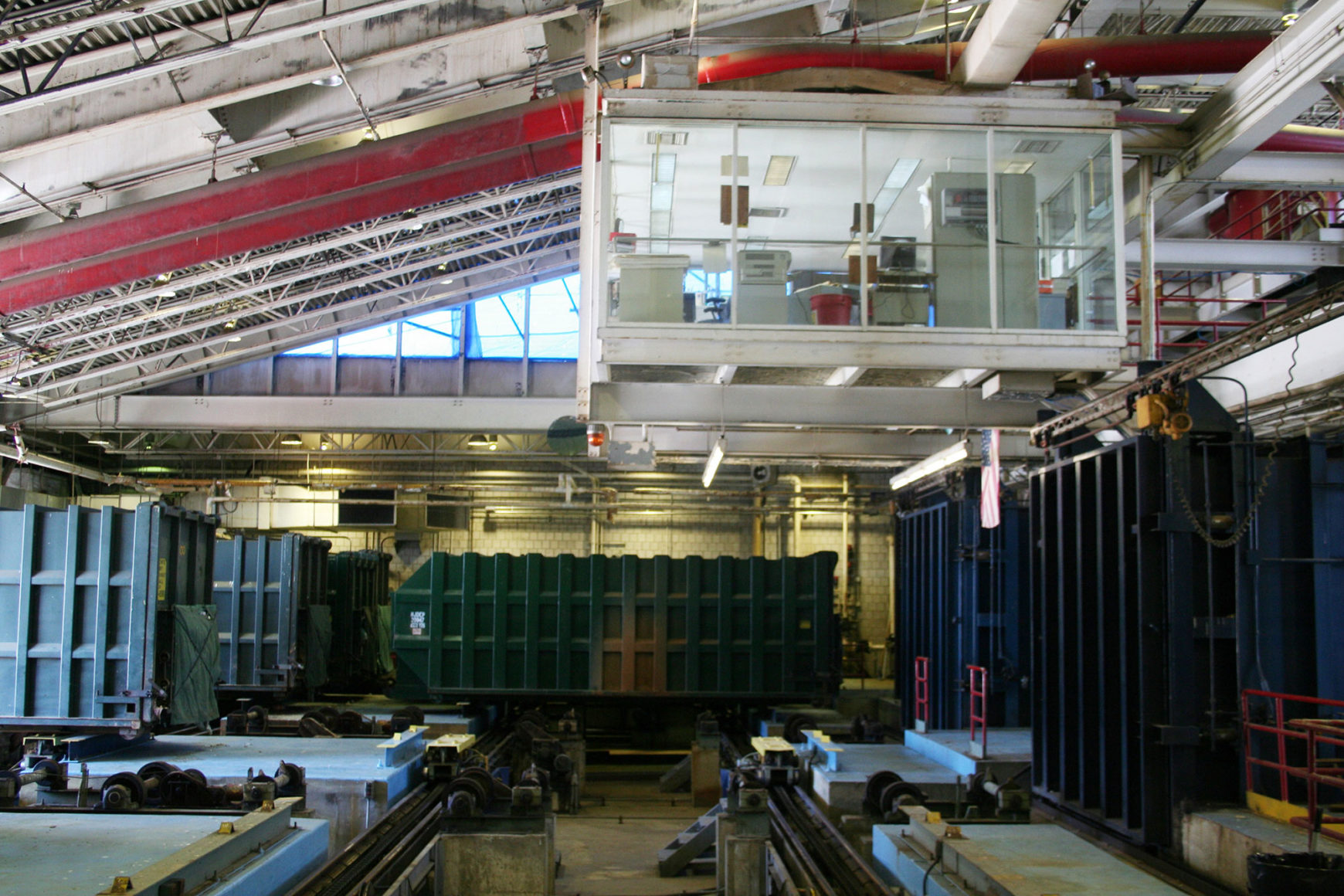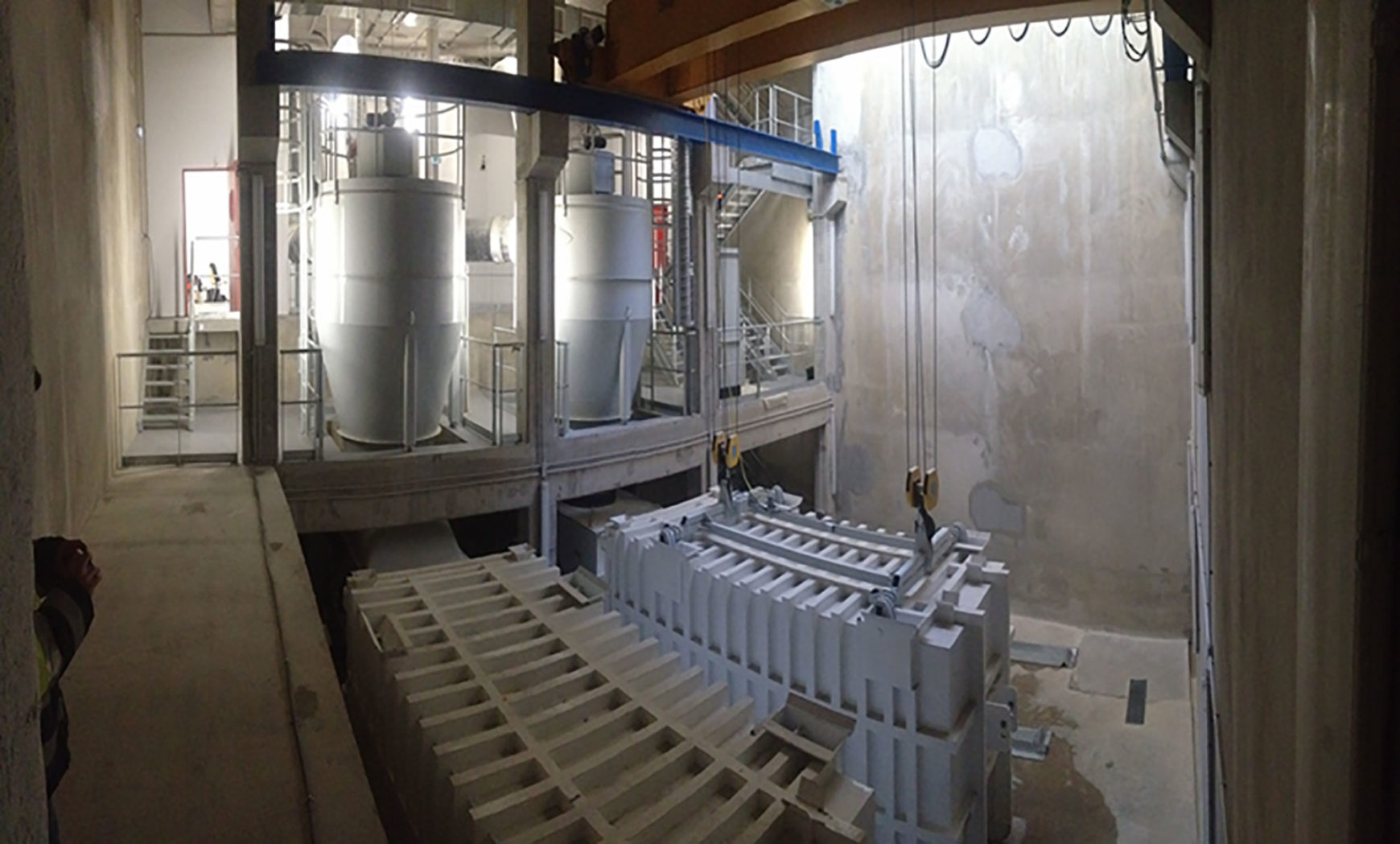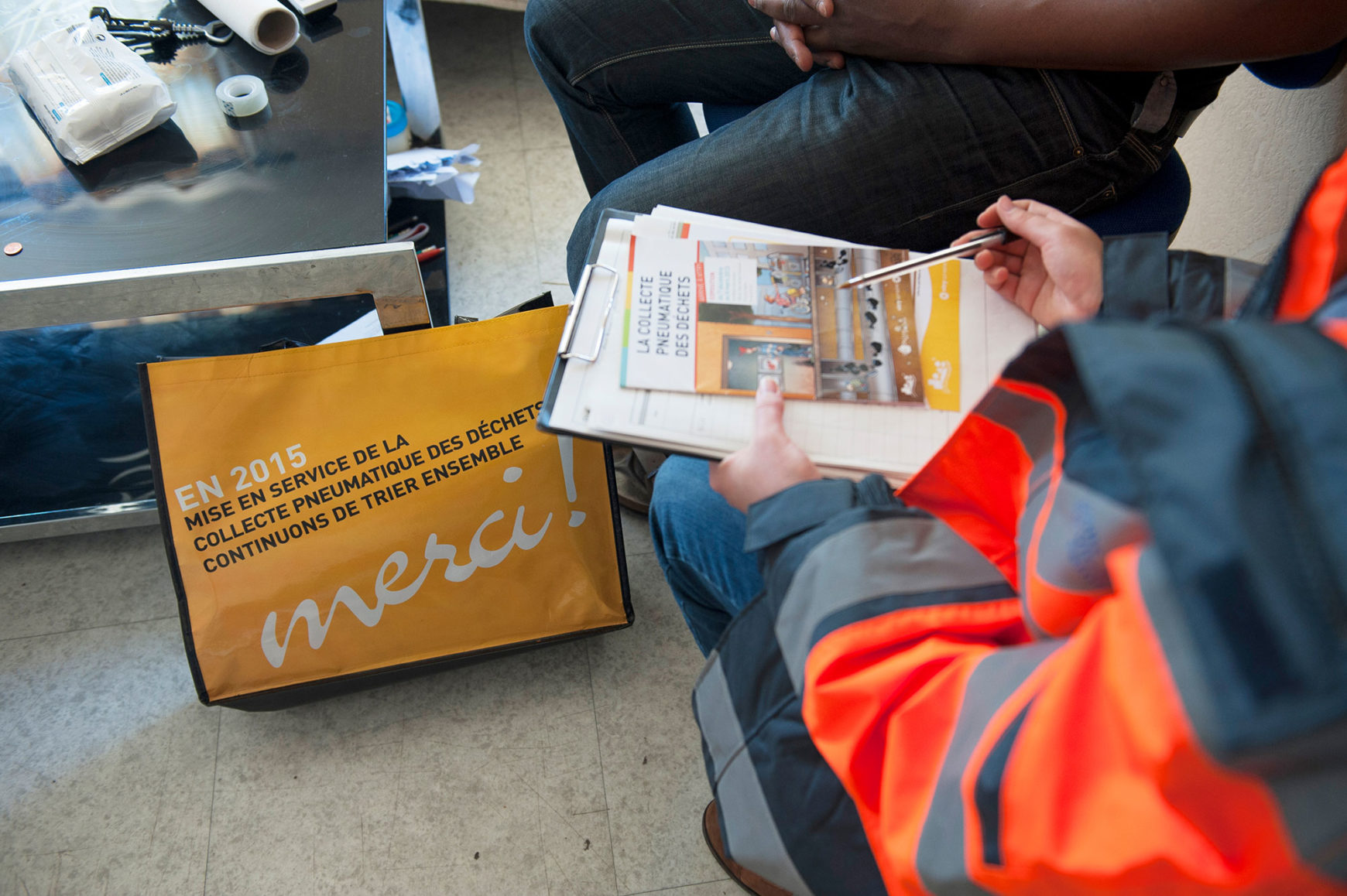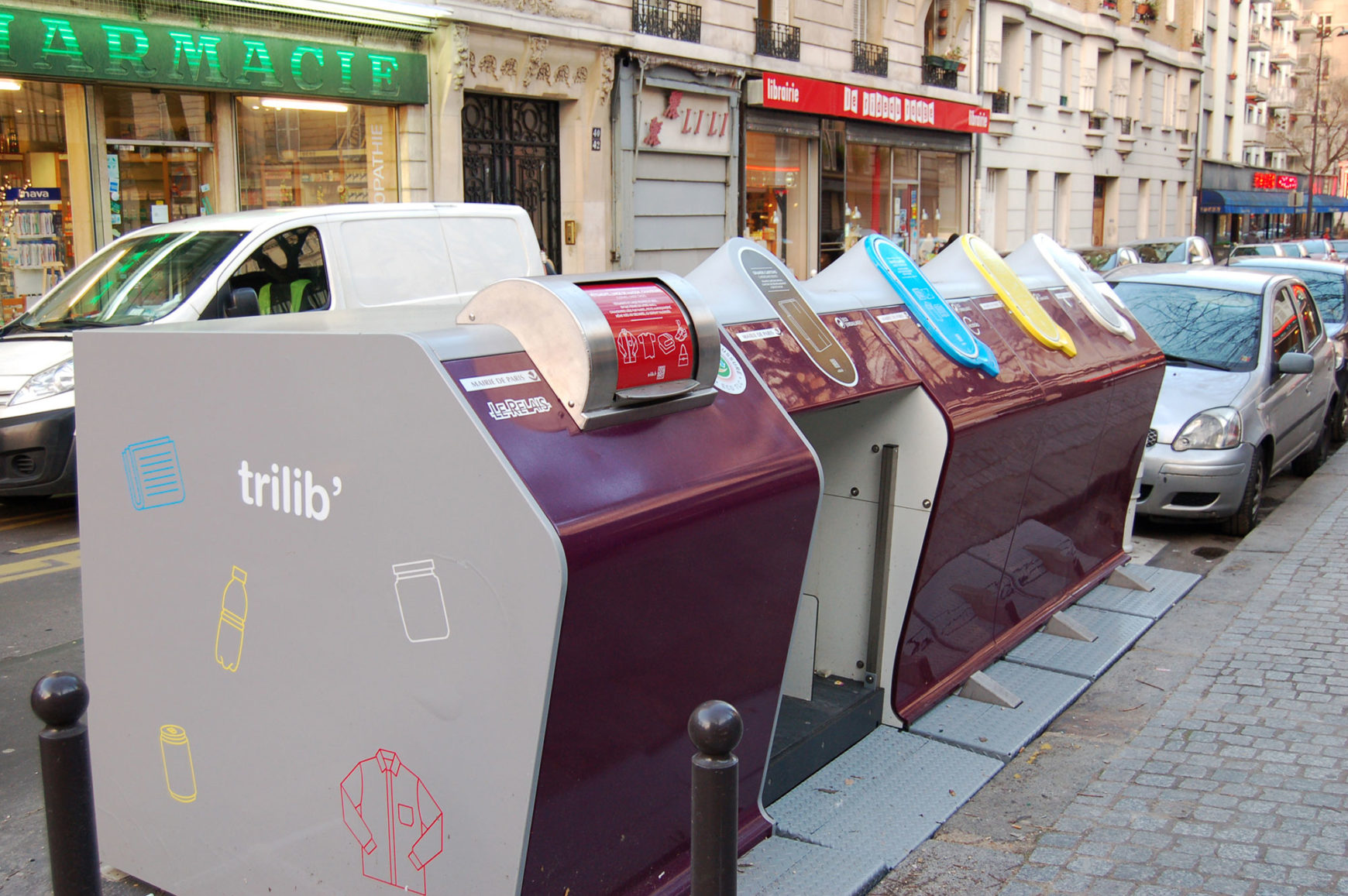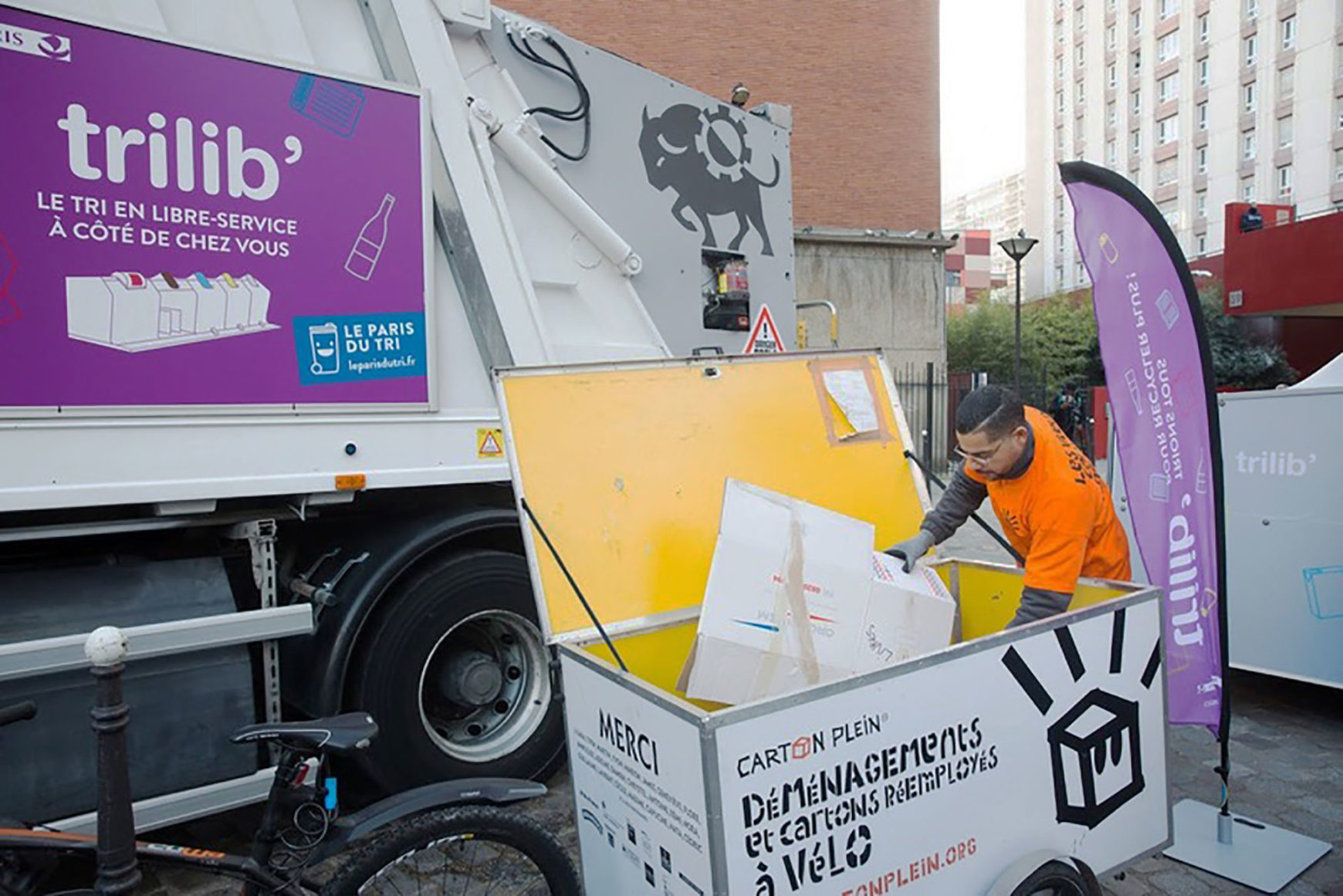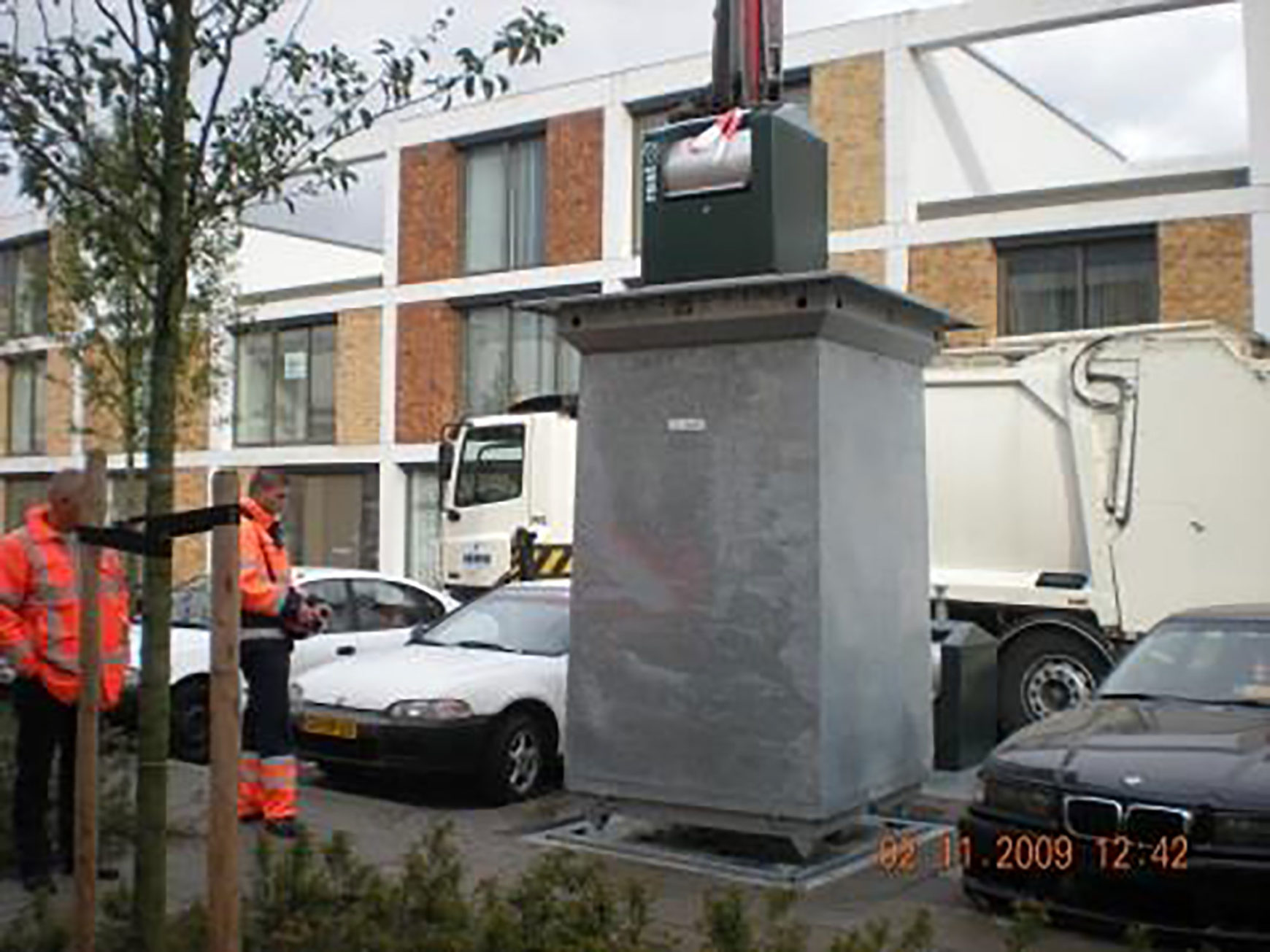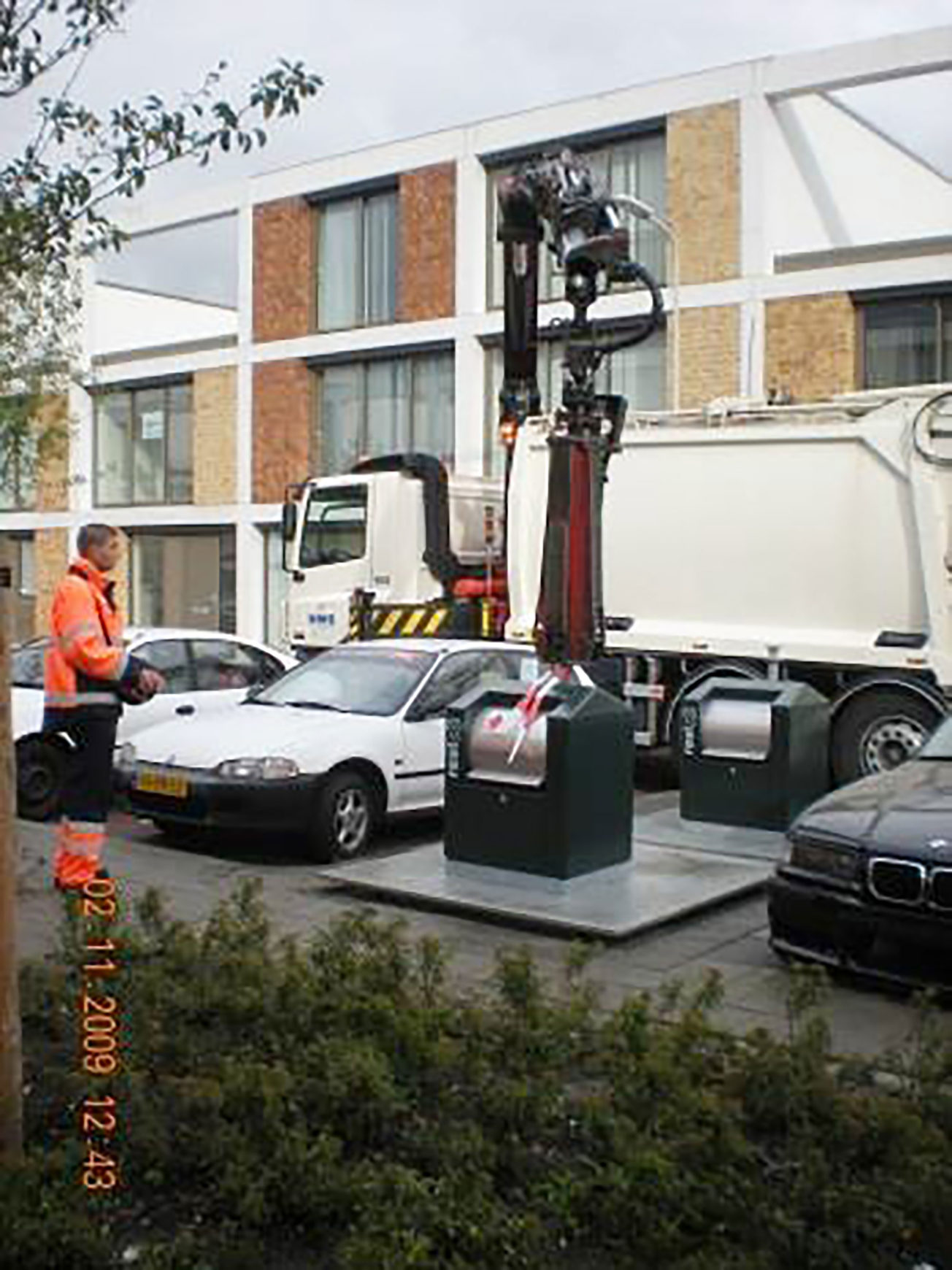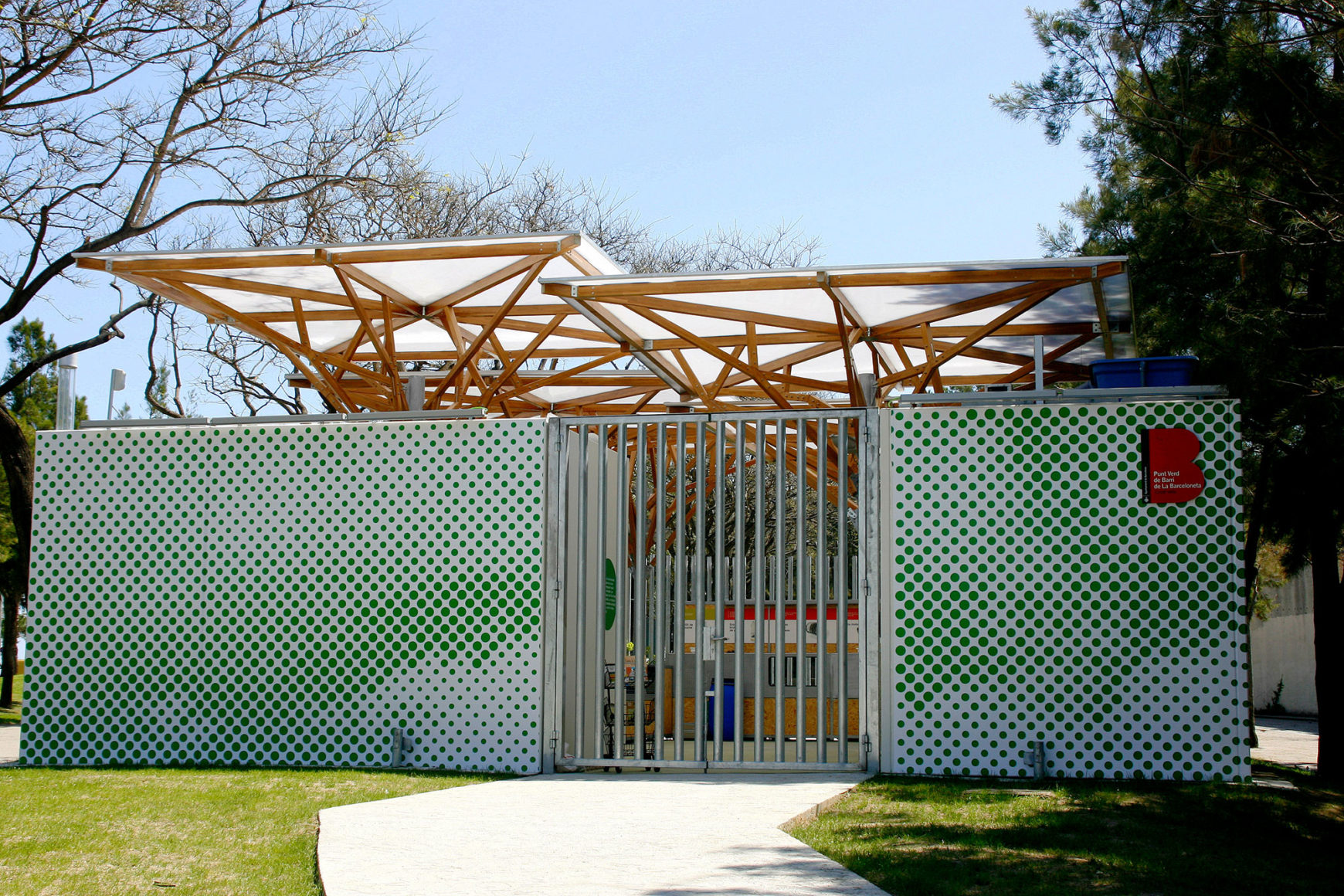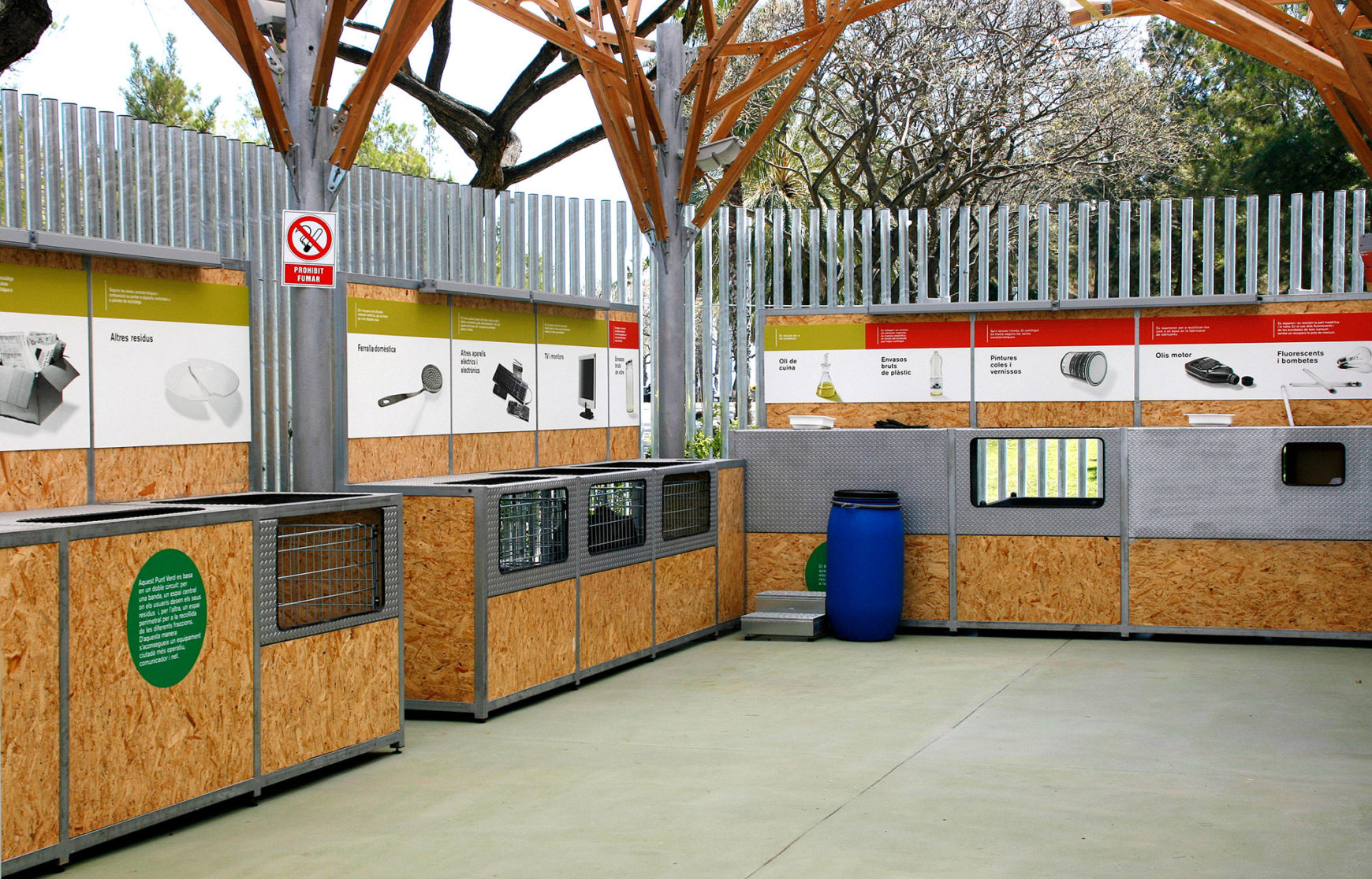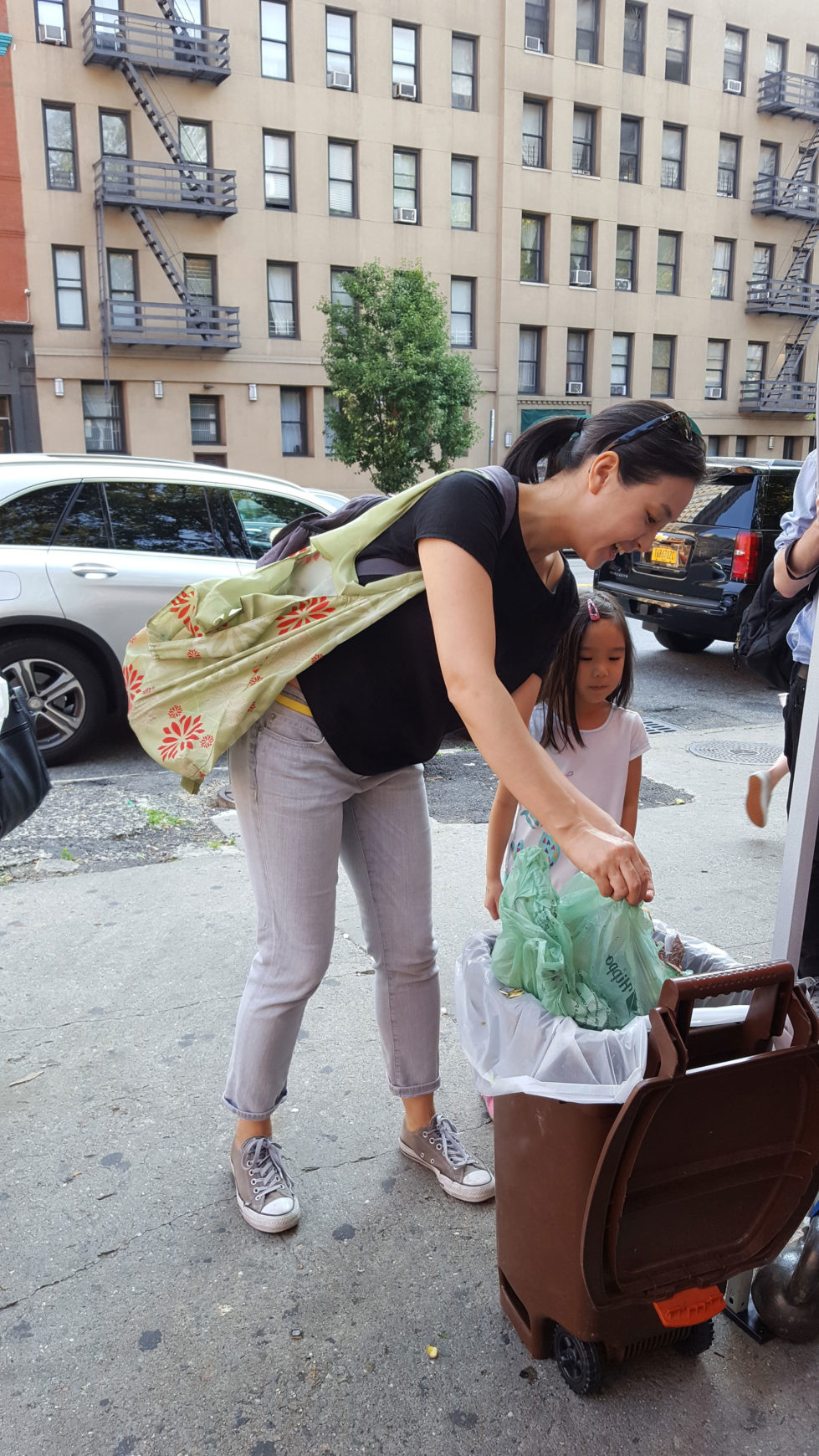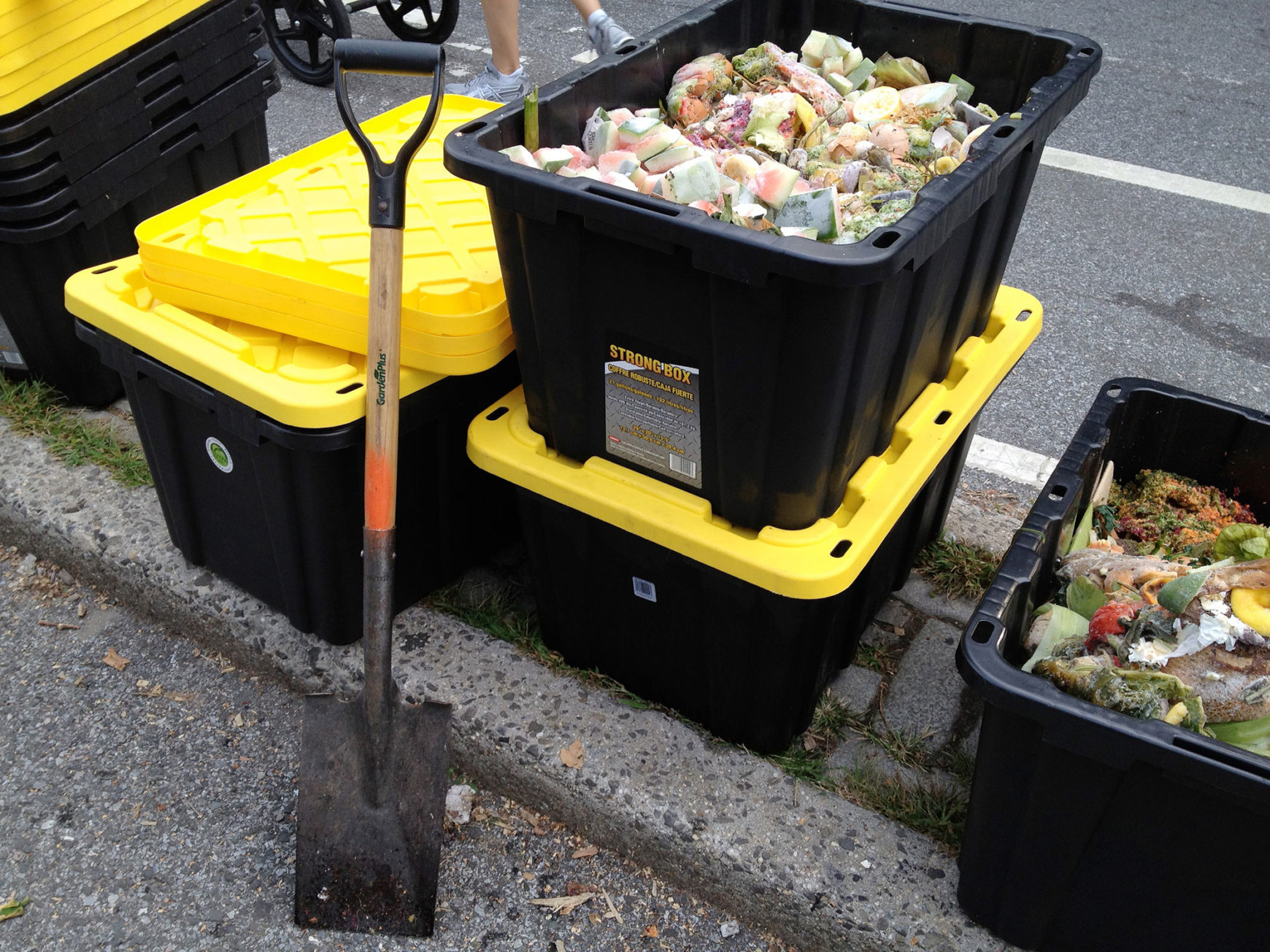Battery Park City, NYC
Type
Shared compactor
Best Practice Strategies
- 3.01 Provide loading area at base of a building that can also be used by other buildings
- 3.09 Incorporate community into collection operations

Building staff bringing waste in tilt trucks to shared compactor managed by Battery Park City Authority
- Building staff transporting waste down the street, loading tilt truck into tipper, BPCA staff emptying tilt truck into compactor
Summary
The planned high-rise community of Battery Park City is home to 14,000 residents, office buildings and public parks along the Hudson River at the southern tip of Manhattan. The Battery Park City Authority (BPCA) leases land to developers whose buildings must meet special requirements for design, sustainability and community amenities. ← Battery Park City Parks Conservancy, “Who We Are,” link; Rigorous environmental standards were added in 2000 and updated in 2005. Battery Park City Authority, “Residential Environmental Guidelines” (5/2005), link.
In 2006, construction of the new World Trade Center site led to an explosion in the rat population. The BPCA responded by amending the neighborhood plan to include several shared loading areas equipped with 35 cu yd compactor containers. Just as building developers were required to provide open space, schools and other amenities, developers of specified sites were required to host compactor containers managed by the Battery Park City Authority. Instead of piling bags of refuse on the sidewalk two days a week for pickup the next morning, porters could now deliver bags to a shared compactor each day. Instead of a compactor truck stopping to load bags from every school and residential building in the neighborhood, roll-on/roll-off trucks collect compacted containers from just four locations.
Compactors can hold 150 carts’ worth of material. Each compactor manages material from about 2,000 units and takes about 90 minutes to load each day. Not only has the strategy addressed the rat issue, but it has also been popular with porters. ← Cheryl McMullen, “How a Compacting Program for NY’s Battery Park City Has Improved Quality of Life,” in Waste 360 (5/18/2017), link; Bill Egbert, “Sanitation Salvation? Battery Park City May Hold the Key to Conquering Downtown’s Garbage Glut,” in Downtown Express (6/16/2016), link.
Challenges
In Battery Park City shared compactor containers are used only for refuse. Metal, glass, plastic, paper and cardboard are still collected door-to-door with rear-load compactors, as are organics from buildings that participate in the city’s organics-collection pilot. Additional loading area space—or separate time windows allocated to each waste fraction—would be required in order to include these source-separated streams in the consolidated-collection system.
The fact that BPCA controls leasing arrangements for the entire development facilitated the shift from door-to-door pick up to consolidated collection. The fact that new developments were in the planning stages made it convenient to install curb cuts in locations that would provide truck access to the shared compactors. Shifting to shared loading docks in existing neighborhoods with multiple private parcel-owners would require coordination between property owners to achieve these ends.
Roosevelt Island, NYC
Type
Pneumatic collection
Best Practice Strategies
-
3.03 Provide a system of pneumatic tubes connecting buildings to a central terminal

Residential trash from all buildings, except the Cornell Tech campus, is collected by pneumatic tube

Operations diagram by Gibbs and Hill engineers showing how waste flows from chutes in individual buildings through a pneumatic tube to a shared compactor container, 1971
- A valve in the building cellar at the base of a gravity chute connects to the pneumatic tube below; View inside the terminal (pneumatic tubes are painted red) including container moving equipment for 30 cu yd containers
Summary
Roosevelt Island is a planned community of 14,000 in the East River, between Manhattan and Queens. The 1969 master plan by Philip Johnson and John Burgee envisioned a full-service community without cars. Tasked with finding a way to remove trash without trucks, engineers installed a pneumatic tube network—the first such system for municipal solid waste in the United States. Trash chutes in the island’s 16 residential complexes are connected via pneumatic tube to a terminal at the islands’s north end. Several times a day, turbines at the collection station are turned on, generating a vacuum. Valves at the bottom of the chutes are opened and trash flows at 50 mph to the terminal, where it is compacted into containers and collected by roll-on/roll-off trucks. ← See Fast Trash: Roosevelt Island’s Pneumatic Tube and the Future of Cities (2010), link.
The system, which has been in continuous operation since the first residents arrived in 1975, has been expanded three times to accommodate new development. The island is managed by the Roosevelt Island Operating Corporation (RIOC), a public benefit corporation of New York State. All developers who lease land from RIOC must connect their buildings to the pneumatic network. As a result, building porters on the island do not manage refuse, and buildings do not provide storage areas for waste. Residents often become aware of the network only on the rare occasions that the system is shut down and bags are piled on the curb, as they are in most New York City neighborhoods. Because collection occurs off the street and without trucks, Roosevelt Island was the sole neighborhood in the city whose DSNY service continued during Hurricane Sandy and the blizzard of 2012.
Challenges
Because the system was built before curbside recycling was required, recycling is not managed by the system. Newer systems incorporate multiple fractions. (See Vitry-sur-Seine case study, below.)
The Roosevelt Island network also does not collect refuse from businesses, because they must contract with private carters. As a result, the system does not run at full capacity.
Vitry-sur-Seine, France
Type
Pneumatic collection
Best Practice Strategies
- 3.03 Provide a system of pneumatic tubes to connect buildings to a central terminal

Residents depositing household waste in an inlet on the sidewalk
- View inside pneumatic terminal, containers are loaded several stories below grade and lifted up to a loading dock with a bridge crane; City staff making home visits to explain how the new system works
Summary
Vitry-sur-Seine is a diverse city of 90,000 outside Paris where 75% of residents live in apartment buildings, a third of which is public housing. In 2008, as the city embarked on a major urban renewal project to improve conditions in several of its public housing estates and to develop an interurban tramline, Vitry was also revisiting its waste management plan; it was looking for ways to encourage recycling and reduce the noise and traffic congestion associated with waste collection. After touring Barcelona’s pneumatic networks, the mayor requested that a study of tube collection be done for the renewal project, with the possibility of connecting other neighborhoods in a later phase. ← Anne Allain and Bruno Allioux, Pneumatic Waste Collection in Vitry-sur-Seine (presentation, International Pneumatic Waste Collection Association seminar, Barcelona Smart City Expo World Congress, 11/16/2016), link.
The first-phase of the system, which will serve an eventual 10,000 apartments, began operation in 2015 and now serves 1,200 apartments, small businesses and a school. Most of the 60 input points activated so far are adjacent to building entrances. (Residential inlets are located outside buildings but on private property, to encourage residents and building managers to take ownership of the inlets and reduce maintenance issues.) Vitry’s system currently collects two streams—mixed recycling and refuse—but was designed to allow for a potential third stream: organics. (Glass and bulk items are collected separately.) ← City of Vitry-sur-Seine, “Collecte pneumatique: le réseau s’étend” (9/30/2016), link.
The terminal sits on narrow parcel between two streets. In order to have enough room for trucks to load inside the small facility, containers are filled underground and raised with a crane bridge to a single street-level loading dock. Large picture windows allow passersby to see into the facility, with the tubes and turbines of its otherwise invisible network.
Some funding for the 32 million euro pneumatic network came from the regional waste authority; the rest was financed by the city via a 5% increase in collection fees implemented over several years. Vitry launched its pneumatic system with a communications campaign that included home visits to 80% of the residents whom the new network would serve. A recent city survey showed the response from residents was overwhelmingly positive. Vitry’s project manager is pleased with the service but notes that the network has not improved separation of recyclables and that more education and outreach is necessary.
Challenges
- Vitry’s pipes were installed in existing streets and sidewalks. Inaccurate below surface survey data caused significant delays and cost increases as the pipes had to be rerouted.
- Contract negotiations were made more challenging by the fact that relatively few manufacturers submitted bids.
Applicability to NYC
New York City could take advantage of large-scale urban renewal and transit projects to install infrastructure that would reduce the impacts of truck collection. Surveys will be critical for any project taking place below city streets. (See The Hague case study, below, on planning for existing conditions.)
Study of High Line Corridor Pneumatic Waste-Management Initiative, NYC
Type
Pneumatic collection, shared containers
Best Practice Strategies
3.04 Provide a system of pneumatic tubes connecting shared inputs to a central facility

Overview of district-scale system and potential area it could serve

Linear rights of way and transportation infrastructure such as the High Line could be used to insert pneumatic collection into existing neighborhoods
Summary
The High Line viaduct was originally built to bring freight into West Chelsea factories by rail. It is now an iconic park surrounded by residential development and offices. Soon it could channel waste out |of the neighborhood and directly onto railcars via pneumatic tube.
The High Line Corridor Pneumatic Waste-Management Initiative proposes a third chapter for the High Line in which building staff and cleaning crews from the local business improvement district cart waste to shared containers connected to a 1.5-mile long pneumatic tube attached to the underside of the High Line. Recyclables, organics and refuse would be pulsed at different times to a collection terminal at the north end of the High Line, compacted into shipping containers and sent by rail to processing and disposal facilities. Space beneath the shared containers could be used as micro-distribution centers for local last-mile package delivery—or to host cardboard balers or drop-off bins for e-waste and textiles. These parking space-size transfer hubs, or shared utility closets, could be located anywhere within reach of the High Line viaduct, including in the loading docks of the large former-industrial buildings the High Line was built to serve. This concept could be replicated in neighborhoods along any of the city’s elevated-subway, rail or roadway viaducts, or shallow (cut-and-cover) subway lines. In addition to the primary trunk line for the three postconsumer streams, a smaller pneumatic tube could be affixed to the High Line to send food scraps from restaurants and food businesses along the corridor to micro-anaerobic digesters, to produce energy for local use.
The New York State Energy Research and Development Authority (NYSERDA) and New York State Department of Transportation have co-funded an effort led by ClosedLoops to advance project pre-planning from the preliminary feasibility/cost-benefit analysis stage (which is already completed) toward potential implementation. The goals of the current project phase are to identify structurally and operationally viable design solutions for installing pneumatic collection along the High Line; to determine optimal operating and ownership models for the shared infrastructure; and to develop the analyses of public and private costs and benefits that are necessary for project financing.32 The current initiative evolved through meetings and site visits with community groups, property owners and city agencies. If implemented, it could be a model for community engagement in planning for district-scale waste management. ← Cole Rosengren, “Below the High Line: How pneumatic tubes could alter the future of urban waste collection,” in Waste Dive (4/6/2017), link.
Challenges
- Multi-stakeholder process involving many properties and city agencies
- Securing space for transfer hubs and collection station
- Business model and project financing
Paris Trilib’
Type
Shared surface container on curb
Best Practice Strategies
- 3.05 Shared surface containers in the public realm or on agency property
- 3.08 Design streetscapes that allow curbside access to containers
- Trilib’ waste streams are collected by several different entities including the nonprofit Carton Plein who collect salvaged boxes by cargo bike and sell them for reuse
Summary
Paris is a low-rise city with one of the highest population densities in Europe. Most buildings are six stories or fewer. Residents are accustomed to bringing their waste and recyclables down to street-level receptacles inside their building. Each morning or night, building staff roll bins from courtyards and entryways to the curb for collection by semi-automated trucks. Paris collects three streams curbside—refuse, recyclables and glass— and may add a fourth: organics (an organics collection pilot was started in two districts in 2017). Meanwhile, many buildings do not have room to store enough wheeled bins to manage the volume they generate. Citywide, 30% of buildings have no receptacles for glass, and 15% still provide only refuse bins. ← City of Paris, Annual Report on Sanitation Service, 2015,” 39, link; City of Paris, Annual Report, 60.
While hosting the United Nations Climate Change Conference in 2016, Paris set out to expand access to recycling collection by introducing a new kind of street furniture. In the spirit of the city’s wildly popular bike sharing program, Vélib’, the new recycling kiosks are called Trilib’ (from trier, “to sort”). The kiosks have foot pedal–operated openings on the sidewalk side and a street-facing door from which sanitation crews remove a wheeled container. Trilib’ kiosks include four to six modules providing access to up to five streams: metal and plastic packaging, paper and small cardboard, glass, textiles and large cardboard, each color-coded with its own type of opening. The number and type of containers varies depending on waste generation characteristics in the immediate area. ← “Paris Teste le Tri de Demain : Trilib,” Eco-Emballages blog (undated), link.
Trilib’ is designed to address a number of issues beyond a lack of storage space within buildings and low recycling rates. These other objectives include giving recycling new legitimacy as an activity deserving of a prominent location in public space and normalizing drop-off down the street as a complementary practice in a city used to door-to-door pickup. The repurposing of parking spots for new kiosks also reinforces the city’s commitment to shifting space away from cars. ← Correspondence with Léon Garaix, deputy director, Paris Office of the Deputy Mayor for Sanitation (7/19/2017).
In 2017, as part of a pilot program, 40 Trilib’ stations were installed in four urban contexts: superblocks of apartment towers, town houses, major public spaces and the historic city center. Preliminary results are encouraging. The volume of material collected via Trilib’ has increased from 50 tons the first month to almost 80 by the sixth. The city envisions installing 1,000 stations by 2020 and is contemplating adding additional containers for other types of material. ← City of Paris, Annual Report on Sanitation Service, 2015,” 39, link.
Challenges
- Capacity: The project team is looking at ways to redesign the kiosks to increase capacity and reduce collection frequency, particularly for bulky materials like cardboard. ← City of Paris, Annual Report on Sanitation Service, 2015,” 39, link.
- Bulky cardboard: Initially, a large opening was provided for bulky cardboard, but this led to problems with overflowing and contamination. Kiosks were modified with a slot opening similar to a large mailbox’s, which seems to be working.
- Noise: The first glass containers were too noisy. The problem was solved by adding sound insulation.
Applicability to NYC
Specially designed surface containers could be installed in public plazas or parking spaces to expand access to recycling in NYC neighborhoods where there is not adequate space for waste storage. Reconceiving bins as public amenities akin to bike-sharing equipment, as Paris has done, could be helpful in siting drop-off stations for a range of materials.
The Hague, Netherlands
Type
Submerged container
Best Practices
- 3.06 Shared submerged containers in the public realm or on public agency property
- 3.09 Incorporate community into collection operations

Truck removing container
- Top to bottom: Truck removing container; Submerged containers installed in a curb extension
Summary
The Hague is the Netherlands’ third-largest city. Until recently, door-to-door collection of refuse in bags or wheeled bins was the norm, with residents carrying recyclables to shared containers on certain “recycle streets.” The city struggled to keep its narrow streets clean because seagulls pecked open bags left out for collection, strewing garbage and making a mess. In 2009, The Hague decided to address the issue by replacing bags on the curb with shared containers submerged under the sidewalk. Although the city anticipated some operational efficiencies, its primary objectives in selecting a submerged container system were to improve public and health and hygiene, enhance public space aesthetics and provide an opportunity for residents dispose of refuse 24/7 instead of having to store the material in their small apartments until pickup day. (Recycling is already collected at drop-off locations.) ← The city found reduced litter where submerged containers were used. “Plans for More Underground Waste Containers,” in The Hague Online (7/25/2012), link; Arjen Baars (director, The Hague Environmental Services) and Richard van Coevoorden (project manager, Department of City Management of the City of The Hague), correspondence with Juliette Spertus, 6/22/2017. Coordinated and translated by Tessa Vlaanderen.
The Hague began switching to submerged containers in 2010 with a plan to install more than 10,000 units in three phases over ten years. In 2017, there were 6,100 below ground units. Eventually, all collection in The Hague will shift to underground containers. The containers are designed to be within convenient walking distance (250 feet [75 meters]) of a residential building’s front door. (If necessary, the containers may be installed at distances up to 410 feet [125 meters].) Each 6.5 cu yd container serves an average of 35-38 households. They are emptied twice weekly and are cleaned, inside and out, twice a year. Equipment is checked once a year. ← The Hague is technology-neutral and has ten-year contracts with multiple vendors. Arjen Baars, 6/22/2017.
The installation process is described in detail on the city’s website. Container location plans are made in collaboration with the municipal committee for public space (an entity composed of key street infrastructure stakeholders, which coordinates short-, medium- and long-term planning), the departments of transportation and environmental services. The city digs test pits in chosen locations to survey underground conditions and informs local residents of the plans. Area residents have the right to object, and if their objections are not resolved to their satisfaction, they can appeal in court. (This has happened in 10% of the cases.) Community outreach occurs at several levels: Information is available online and letters are sent to all residents to explain why the change is being made. During the neighborhood information evenings that are organized to discuss plans with the community, residents can volunteer to be responsible for a submerged container and receive the tools to repair basic jams. Volunteers are usually the first to call when issues arise.
The primary operational change for collection personnel is that truck crews are reduced from three to one, and some training is needed to provide the skills needed to manage the equipment. The shift to submerged containers has led to improved working conditions and reduced labor costs. A shift from fixed routes to a flexible “smart schedule” based on sensors will be implemented next. ← One sanitation worker would be possible, but the perceived security risk and difficulty of maneuvering narrow streets made them keep two. Arjen Baars, 6/22/2017.
Challenges
Although litter is reduced, the city maintains a cleaning crew to address the 2–3% of locations where bags are improperly discarded beside containers. There is a fine for illegal dumping, but identifying an owner is nearly impossible. Community involvement and ownership is the most powerful solution. ← Arjen Baars, 6/22/2017.
Applicability to NYC
New York City is similar to The Hague in that it is a dense city with infrastructure and utility systems running under its streets. The Hague’s implementation process, involving coordination among key street infrastructure agencies, with test pits to check field conditions, would be appropriate in NYC as well. DSNY’s existing Adopt-a-Basket program could be expanded to include training volunteers to be first responders who could resolve minor maintenance issues with their “adopted” submerged containers. (See BPS 3.06 for collection considerations.)
Punt Verd, Barcelona
Type
Neighborhood-scale recycling center in public realm
Best practices
- 3.07 Staffed drop-off locations
- 3.09 Incorporate community into collection operations
- View of pedestrian entrance; Interior view showing receptacles for various materials

Plan showing containers arranged around a public drop off area with service access around the perimeter
Summary
Punts verds (Catalan for “green points”) are small recycling centers installed in plazas and parks. Barcelona developed the semi-permanent staffed facilities to provide residents with opportunities to drop off household hazardous waste, recyclables and smaller bulk items within walking distance of their homes. Punts verds complement larger recycling centers with vehicle access on the outskirts of the city. In 2016, the city’s 23 neighborhood-scale punts verds managed over 2,000 tons of material. ← See Neighborhood Punts Verds labeled “B” in location map, City of Barcelona, Xarxa Punts Verds, link.
The facility design is simple: containers are arranged in such a way that they are accessible for deposits by the public on one side and for emptying by staff on the other. The center is protected from the elements and secured with fences. The only interior spaces are a small office with a restroom for staff and a tiny visitor’s center. Punt verds are designed to be eye-catching to encourage their use and to add visual interest to the surrounding public space. They also provide an opportunity to showcase sustainable design. The modular facility installed in Barceloneta Park in 2013, by Picharchitects, features a planted enclosure and requires little energy for operations: Roofs protecting the drop-off area capture rainwater and fill cisterns used to irrigate planters; solar panels and passive systems generate electricity and hot water. ← Picharchitects, “In Process: Punt Verd, Nuevo Modelo de Punto Verde en la Barceloneta,” Picharcthitects (blog, undated), link.
Challenges
Architect Felipe Pich-Aguilera Baurier explains: This is not a conventional project. Every aspect had to be invented from scratch to break with the conventional image of a waste plant. A waste project is always subject to “industrial” constraints, such as accommodating truck logistics and ensuring that the site is protected from contamination. For this project, very restrictive safety and hygiene measures were also necessary to ensure coexistence within the urban fabric. As a result, projects tend to be isolated like “bunkers” and would be intimidating to pedestrians and neighbors. Our project tries to achieve a domestic-scale result that can be a meeting place for the neighborhood, while addressing all of the program requirements.
Given that the installation is located at the edge of an urban park, we have tried to design the largest elements so that they assimilate directly with the natural landscape that surrounds them and ensure that no permanent mark is left on the ground. To do this, all the components have been manufactured offsite and assembled so that the facility can be dismantled and removed. ← Note from architect, Felipe Pich-Aguilera Baurier, 9/2017. Translated and edited by Juliette Spertus.
Applicability to NYC
New York City runs SAFE disposal events throughout the five boroughs, where the events are typically well attended and waiting lines can last for hours. Research elsewhere has shown a spike in trash disposal of hazardous waste on days following collection events. Permanent facilities providing predictable, ongoing access to collection could capture a larger portion of materials designated for diversion from regular disposal.
Ménilmontant, Paris
Type
Recycling center and relay point for bulk collection hosted on private property
Best practice Strategies
- 3.07 Staffed drop-off locations
- 3.09 Incorporate community into collection operations

Section perspective showing vehicles driving into the recycling center adjacent to the gym

Diagram showing the various program elements

View showing pedestrian-oriented context

Plan of basement level; municipal vehicles stage material in large containers while the public drops off at small containers the length of the exterior wall
Summary
The City of Paris and Paris-Habitat OPH, a public housing management company, are building a new mixed-use residential complex of 87 units in the Ménilmontant neighborhood of the 20th arrondissement. In addition to the more conventional park and sports complex, the project, designed by Atelier Nadau Lavergne, includes a staffed recycling center or “espace tri”, as well as a hub for aggregating truckloads of bulk materials picked up by appointment from local collection routes. Parisians are already required to bring household hazardous wastes and other material not collected curbside to an espace tri, where materials are staged and sorted before being sent to processing or disposal facilities. These centers tend to be open-air facilities in industrial areas around the expressway that circles the city, with difficult pedestrian access. ← Nadau Lavergne website, link.
The 15,000-square-foot espace tri was included in the program for a mixed-use building in an effort to bring recycling centers closer to where people live and design them in ways that minimize impacts from their operation. The hub for aggregating loads of bulk materials, called the Point Relais d’Encombrant, will reduce miles logged by collection trucks, in turn decreasing congestion and air emissions. By 2020, every arrondissement will have a center—coordinated by a partner organization—where residents will be able to take items for reuse as well as recycling and disposal. To reach this goal, the City will build ten new espaces tri, including the one in Ménilmontant, the first to be located in a residential complex. ← “Une déchèterie sous le sol de Paris,” in Environment Magazine (9/23/2015), link; Laetitita Van Eeckhout, “Très mauvais élève, Paris se lance vers le ‘zéro déchet’” in Le Monde (2/16/2016), link.
Challenges
The project team must reassure neighbors that any negative impacts from this new type of facility will be mitigated.
Applicability to NYC
New York City does not have a network of neighborhood-scale facilities collecting household hazardous waste and other non-daily streams. Both the Ménilmontant and Barcelona programs offer convenient and reliable access to neighborhood drop-off facilities. City agencies could specify that publicly funded projects host such facilities, along with the logistics support required to operate and maintain them. (See the Punt Verd case study, above.)
GrowNYC Compost On-The-Go Program, NYC
Type
Staffed drop-off locations in the public realm
Best practice
- 3.07 Provide staffed drop-off locations.

Commuter drop off at transit hub
- Food scraps dropped into DSNY toter; Crates of food scraps at a GreenMarket drop-off
Summary
Dedicated New York City gardeners have composted in their community gardens for decades as a way to improve soil for flowers and vegetables. In 1993, the New York City Department of Sanitation created the NYC Compost Project to leverage this interest in composting and began formally training community gardeners through the city’s botanical gardens to become certified master composters. DSNY has since expanded the scope of the compost project to help develop organics collection and processing capacity in the city with the Local Organics Recovery Program (LORP). LORP sites collect food scraps from the larger community and process them in their urban compost sites.
Concurrently, DSNY began funding collection programs in farmer’s markets, parks, libraries and commuter drop-offs at subway stations. These drop-offs are intended to complement curbside collection, providing convenient access to organics collection for all New Yorkers by 2018. ← Nora Goldstein, Part I: “Community Composting in New York City” (1/2013), link, and Part II: “Greenmarkets Facilitate Food Scraps Diversion in NYC” (2/2014), in BioCycle, link; NYC DSNY, “NYC Organics Collection: Neighborhoods Served,” link.
The newest DSNY-funded food scrap drop-off effort is called Compost On-The-Go, operated by GrowNYC, DSNY’s nonprofit partner. GrowNYC compost coordinators set up a tent with bins or crates for organics and a refuse bin for any plastic bags used to transport material. For commuter drop-offs, bins are placed on street corners near a subway entrance in time for the morning rush hour. In addition to managing the bins, coordinators provide education and outreach about the importance of organics diversion in NYC. Commuters tend to travel at the same time each day, so volumes increase from week to week as people learn about the program and start saving their food scraps for drop off on their way to work.
Citywide, there are now 106 food scrap drop-off sites. ← Correspondence with DSNY, September 2017.
Challenges
Unlike the curbside program, in which organics are treated in industrial facilities, the drop-off program often uses urban compost facilities and gardens that are only allowed to accept plant-based material. ← GrowNYC, “Compost Food Scraps,” link.
Share this page Next Section: Overview →
